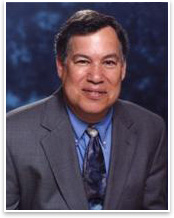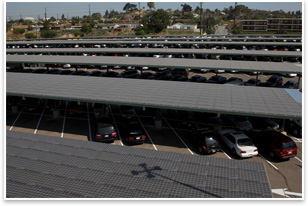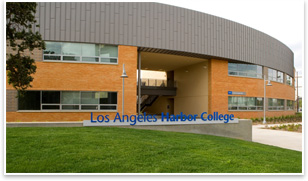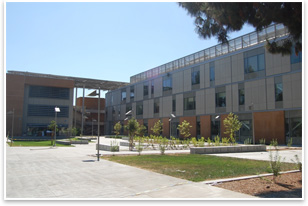| Larry H. Eisenberg administers a $6-billion campus construction program in Los Angeles
by Tracy Ostroff
Contributing Editor
 Summary: Larry H. Eisenberg, executive director of Facilities Planning and Development, directs the Los Angles Community College District’s (LACCD) award-winning $6 billion “green” construction and modernization program—one of the largest public-sector sustainable building programs in the nation—and its renewable energy program. He also oversees all planning, facilities development, maintenance, and real estate activities at the district. By the time the construction program is complete, the district’s nine campuses will feature almost 100 new buildings that exceed the USGBC’s LEED™ Certified standards, including nearly 50 “zero-energy” buildings. The campuses also are on track to produce enough renewable power to be energy independent. Summary: Larry H. Eisenberg, executive director of Facilities Planning and Development, directs the Los Angles Community College District’s (LACCD) award-winning $6 billion “green” construction and modernization program—one of the largest public-sector sustainable building programs in the nation—and its renewable energy program. He also oversees all planning, facilities development, maintenance, and real estate activities at the district. By the time the construction program is complete, the district’s nine campuses will feature almost 100 new buildings that exceed the USGBC’s LEED™ Certified standards, including nearly 50 “zero-energy” buildings. The campuses also are on track to produce enough renewable power to be energy independent.
What is your relationship like with the architectural community?
Through this program, because we have so many things going on, we employ almost 200 firms across Southern California, most in the L.A. area, but some beyond.
How are projects funded?
Under our first two bonds we have about $2.2 billion to build 42 new buildings. We currently have most of those under way, and most of them have been finished at this point. Then the new measure, which passed on November 4, will provide $3.5 billion in funding. Besides that, we get a couple of hundred million in state funding, which rounds it up to $6 billion or so. Basically, that does 50 new buildings, and a series of remodels as well.
We have been pursuing stimulus funding. From our perspective, the money hasn’t trickled to our level. The area where it will be particularly beneficial is back on the operating side, and that is where we’re starting to see money come through for our workforce training activities. That has real value and allows us to bring more students in and offer a broader range of programs.
 What is your design process? What is your design process?
Of those 50 new buildings, at the moment we’re contemplating that 30 will be delivered through design-build. That requires the formation of a comprehensive team on the part of both contractor and architect to come forward. We’re selecting for that by asking for qualifications for the team. Once we have a short list, we have them respond to the formal request for proposals.
What we have done in the design-build area is issue periodic calls, asking firms to provide their qualifications. If a campus wants to do a library, then we already have 10 different firms qualified to be library designers. We give the college that list of 10 firms. They find the ones they like at face value, and we bring a short list in for an interview and have them do the RFP. We’re just finishing the latest opening for design-bid-build, and we’ll be looking at firms, teams in this case, and we’ll add them to the list. And then there will be a gap for a while. I would guess in another four to six months we’ll open it again.
How does technology influence design and construction?
One of the things I wanted to do in coming here, was to create a comprehensive geographic information system that would provide a warehouse of data about our built environment across our colleges. To do that, I created this function that we call our E7 Studio. It is a handful of talented computer architect professionals and then many students who have background and scope in doing that, and 30 to 40 interns. We are doing computer-aided fly-throughs as they go through design.
Our users are well motivated, intelligent people, but mostly have never participated in a capital project. So instead of just having a sheaf of drawings, they can use the fly-through to help them understand the physical reality of what they are asking for and what they are going to get. We are taking our existing buildings and loading them into our GIS system. And we are placing touch-screen kiosks into building lobbies to provide background information about the building and our sustainable program.
Finally, we now we want each of these 50 new buildings to be designed in a BIM context, so that when that BIM model is incorporated into the GIS it will provide an excellent reference resource for operations and maintenance. We also think BIM has the possibility to be a great tool to help us define elements of a building in a sustainable context and incorporate that information into the building model. So that brings it together for us to commit to sustainability.
 Do your technology requirements pose a barrier for firms to work with your office? Do your technology requirements pose a barrier for firms to work with your office?
We did a survey across the broad range of architecture firms that work for us, and about 92 percent said they have Revit and are doing BIM as part of their work. There has been a huge education effort. The other thing that makes this possible is that the interns from our E7 function are getting great jobs in the industry. The big and small firms are snapping them up as they come through. We are creating our own training pool of talent.
How is the program affecting the local economy?
It really is a significant boost to the Southern California economy, in terms of the number of jobs. We probably have about 30 major buildings that we’re building, and I would guess that most of those have 50 to 100 people a day working on them.
There is another benefit for us. Because we have the cash and we’re interested in building, the numbers are coming in amazingly well for those jobs we’re doing hard bid on, in some cases 30 to 40 percent below estimate. The other side is that we have seen an 11 percent increase in student enrollment. We’re offering a curriculum in what we are describing as the “green job arena,” so that we can help people into the industries we think are going to be a part of revitalizing the economy.
How has the LACCD become a more sustainable entity?
The effort really began with our Board of Trustees. I have tremendous respect for our board, and I describe what they did as a courageous action because they adopted the policy in 2002 to adopt the sustainable building goals, which required buildings to be designed to LEED-certified standards and each team to have a LEED-AP.
Part of the adoption of the policy was the idea that as we do it in our physical environment that we can teach it so we can be a model for the community, show people how these kind of things can be done, and give students the opportunity to learn about the new technologies and have first-hand access outside the classroom.
Also, as we started moving through the building process, I realized we could influence the products that we are buying and how they were produced. For example, we were going to buy $100 million worth of furniture that had rigorous sustainable standards. The companies that ultimately won that contract changed their factories to produce the kind of products that we wanted. They stopped using certain materials and started using others. That kind of buying power makes things happen.
The unique nature of one of these multi-year, high funded, public sector programs is that we can learn from our own experience. For example, we looked at our sustainable program and our LEED program and realized that we weren’t getting complete engagement. So we’ve created a new document called Sustainable Design Standards. It provides breakdown by LEED categories and we crosswalk to the Construction Specifications Institute divisions. Glumac and Gensler teamed up to help us do this, and it will be widely available.
 What is your guiding energy policy? What is your guiding energy policy?
Part of the board’s policy in 2002 was to ask us to explore renewable energy solutions. The policy they set at that point was that a minimum 10 percent of energy in the new buildings should be from renewable sources, and they hoped it would be 25 percent. Once we began working on this issue, we saw that it was actually possible to think about 100 percent of our power from renewable sources. We are urging the architectural community to really think carefully and offer us designs that try to fulfill that goal. The early projects we are seeing are really doing quite well.
Originally, we thought we could go off grid and snip the wires, and the reality is that we will have more than enough capability to do that. But we see it would make more sense to sell the excess energy at certain times of the day back to the local utilities, and make a little bit of profit in the process. To make that happen, we have to cover all of our areas with some kind of renewable technology to achieve the power and generation we need. Any place we can find it ,think about it, and do it, we need to.
What are the qualities you are looking for in a design firm?
I look for the things you would expect, including how creative and cost conscious they can be in delivering that. We have a limited budget, but I want great architecture. When they are given that challenge, often they can be really responsive to come up with something that is lovely and makes the statement that needs to be made. Someone does well who is flexible, comfortable working in a shared governance environment, and delivers technological solutions to work with us in the BIM and fly-through context.
I like architects who are a little more assertive. My feeling is that the architectural community has felt sort of beat up; that the architecture, engineering, contracting community has gotten pretty litigious. Concerns about liability and insurance and that kind of thing makes people sometimes a little gun-shy. My hope is that we can get past that. Yes these things are there, and they are a fact of life for us. But, at the same time, it shouldn’t limit our ability to have that kind of creative spirit and flexibility to come up with interesting concepts and work in a proactive way with owners to make things happen. |


 Summary:
Summary: What is your design process?
What is your design process? Do your technology requirements pose a barrier for firms to work with your office?
Do your technology requirements pose a barrier for firms to work with your office? What is your guiding energy policy?
What is your guiding energy policy?